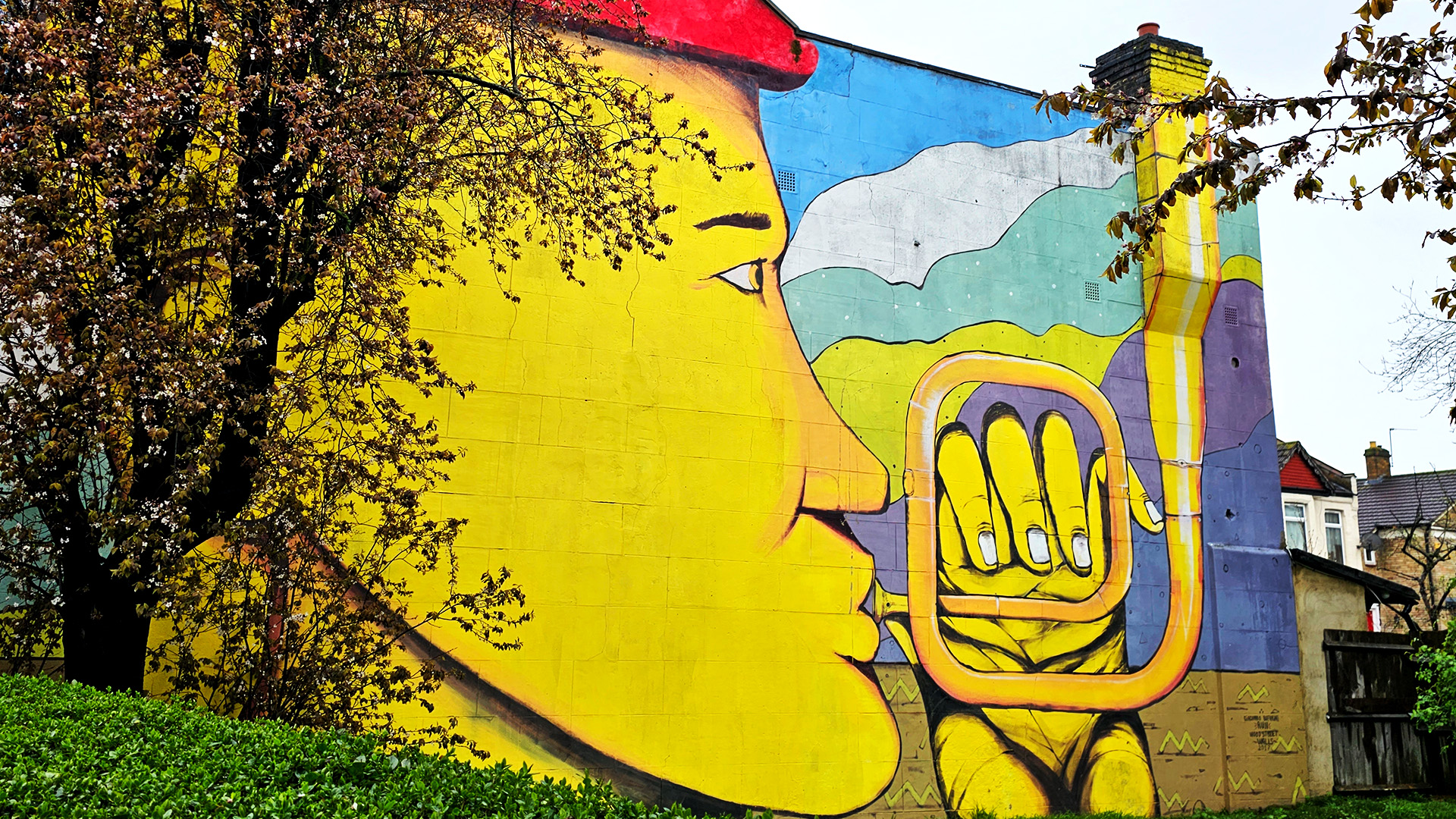All images courtesy of Historic England Archive / Alun Bull
It would be untrue to say that the interior of Ron Gittins’ Merseyside flat came as a complete surprise to those who knew him.
After all, he had always loved art and there had been a clue about what might lie in store when he built 8ft columns either side of his front door, covering them in reliefs referencing the Battle of Actium. And then there was the time he painted scenes from Pompeii around his bedroom at his parents’ home.
But still, over the 30-plus years he lived there, very few people had been inside his home. After his death in September 2019, Ron’s sister Pat went round to sort through his things, and even she was unprepared for the full scale of his creativity.
Covering every wall and many ceilings, Ron had filled his home with an extraordinary series of murals, portraits and images, often copied from the classical world. Home-made period outfits spilled from wardrobes and hung on the back of doors; maquettes that he had constructed lay on the floor or sat in chairs; a collection of papier-mâché heads was lined up on a table. Piled everywhere, were the art and history books that Ron had collected over the years.
Perhaps even more improbably, Pat and her husband discovered that he had flourished as a sculptor: the chimney breast in the living room had been transformed into a snarling lion’s head. And in the room that Ron used as a studio, he had built a gigantic bull’s head.
“We knew he made artwork, but we had no idea about the fireplace sculptures,” says Jan Williams, Ron’s niece, a professional artist who runs the touring The Caravan Gallery with her partner, Chris Teasdale. They were on their way to Barrow in the north west of England, to set up an exhibition, when her mother called in a panic. Fatefully, Jan decided to stop off at the flat en route. “When I got there, I thought, ‘We can’t afford to lose this, it’s too special’.”
Having worked with found materials and community groups for much of her career, Jan recognised that she had stumbled across one of the most fully-realised examples of ‘outsider art’ – art by people without any formal training, who work outside the art world’s confines – she was ever likely to encounter. And, without intending to, her decision to preserve her uncle’s flat set the course for one of the most unlikely feelgood stories of recent years: a triumph of community action against corporate interests, of audacity over conformity and, ultimately, of an outsider’s victory over the establishment.
But where do you begin with attempting to preserve a property like Ron’s, especially one that was rented?
First image: Ron's house in Birkenhead.
Second image: Hallway with Egyptian-style designs
Raising awareness
Jan’s first task was to drum up publicity and she managed to get some coverage in the local paper, the Liverpool Echo. In the first of the many instances of serendipity that were to come, she was immediately contacted by Martin Wallace, a filmmaker living just a few miles away from Ron’s home. In the late 1990s, he had made a TV series about outsider art with Jarvis Cocker of Pulp, Journeys into the Outside with Jarvis.
“When I walked through the door the first time, I felt privileged to get to see and experience the place,” says Wallace, who rushed down to photograph and video the flat the day after he spoke with Jan. “I believed the most likely scenario was that it would be ripped apart… I’d seen elsewhere that just because you think something is great and deserves to be saved, doesn’t mean it can’t be wiped away in the name of somebody else’s idea of progress.”
He describes a sense of wonder on seeing Ron’s work on that initial visit. Ron Gittins might not have been a perfectionist draughtsman but it is his commitment to his artistic expression that’s crucial, his imagination, his apparent inability to limit himself. Jan describes it as a “visionary environment” and it is impossible to walk around the flat, with frescoes Ron copied from books about Pompeii, its hallway which is a tribute to Ancient Egypt, and its romanticised 18th century Grand Tour room, without an overwhelming sensation of admiration for his uninhibited joy in creativity. Even the bathroom has been covered in an underwater scene – giant fish swim over the walls and frogs and dragonflies skitter across the ceiling.
Sean Pearson AssocRICS, director of Trust Surveyors, says if he discovered something like Ron’s Place during a residential survey it would be a very interesting property to inspect, but “it would not be for the faint of heart”.
“Depending on the instruction, a surveyor would need to be able to identify the building elements to advise clients on condition and future implications,” says Pearson. “Something as unusual as this, with much of the actual building’s fabric concealed, would create a unique challenge.”
If they were to save it, Martin and Jan’s first challenge would be getting the landlord on side. Ron did not own his flat and while most tenants in the UK are not allowed even to nail picture hooks into the walls, he had taken personalisation to an extreme. His home had become his canvas. (Although Ron’s flat had been sold several times during his occupation, he had retained the secure tenant rights from his initial 1980s tenancy.)
His final landlord, a company with many, many properties, might not have known what Ron was up to or might have turned a blind eye. It’s possible that the directors were simply marking time until they could take the property back and sell it on. They had kept the rest of the handsome Edwardian villa empty and, while shabby, its location in the leafy suburb of Oxton made it ideal for redevelopment.
Having raised £8,000 in the first few weeks of crowdfunding, Martin and Jan were in negotiations with the landlord to keep renting the flat when COVID-19 struck. With immediate prospects uncertain, the landlord agreed to their suggestion that the newly formed Ron’s Place group cover rent and utilities while trying to find a longer-term future for the building. “We thought we would partner with a housing association, they’d have the three flats upstairs and we’d make Ron’s into a bespoke museum, something quite unique,” says Wallace. “We didn’t just want it to be a novelty, it had to be relevant to the local community.”
But while the pandemic gave them breathing space, it also made it harder to raise money to preserve the building: they had open days and Jarvis, by then also a patron, donated profits from events he held in Liverpool but it was not nearly enough. By 2022, none of the housing associations they had approached were willing to take the building on and the landlord, tired of waiting, announced that it would be put up for sale for £465,000. The trustees had not raised even 10% of that amount.
However, Pearson believes the condition of the flat would make it a tricky sale. “If this was put up for sale on the open market, many high street lenders would not accept the property due to its condition and unusual contents. It would more than likely be classed as ‘not suitable for mortgage’.”
“If this was put up for sale on the open market, many high street lenders would not accept the property due to its condition and unusual contents” Sean Pearson AssocRICS, Trust Surveyors
First image: The 'Minotaur Room'
Second image: Under the sea themed bathroom
A cunning plan
The group became more cunning to buy themselves more time. They applied to Historic England for a preservation order, known as a listing. Then, when the house was open for viewings, told potential buyers that the listing – which would make alterations almost impossible but was by no means certain – was imminent. In 2023, the landlord countered by putting the building up for auction.
The day of the auction was 1 March 2023 and Martin had pretty much given up on Ron’s Place being saved. “I was almost relieved it was over at that stage because it had taken over my life.” Then the morning of the auction, he received an email from a stranger which said “I think I can help you”.
Martin had had a lot of these sorts of emails over the past few years from people who, while well-intentioned, turned out not to be that helpful. He’d even said to Jan a few days before, “It’s not as if we’ll just get a rich benefactor.” Nevertheless, he telephoned the sender, Tamsin Wimhurst. Tamsin was helpful. Together with her husband, Mike Muller, she had established a philanthropic fund which had already helped to save the David Parr House, a worker’s cottage in Cambridge which had been intricately decorated by its owner more than a hundred years before. Stuck on a train, she had found an old copy of the Guardian in her bag and seen a report about the imminent sale of Ron’s Place.
“Of all the people who saw that article, she was the one that could help,” says Wallace. “She’d never seen Ron’s Place but she said she would loan us the money. And then she said she would buy it.”
There was just one problem: at auction a 10% deposit is required at the fall of the hammer and Ron’s Place did not have those funds. Tamsin, their fairy godmother, was unable to send anything immediately. With yet another piece of luck, Martin and Jan checked the catalogue and found that the auction house could only accept funds up to a maximum of £10,000. They bid and, having effectively scared off any local developers with the threat of a listing, bought the building for £335,000. “We were the only bidders,” says Wallace.
The ownership of the building has been secured by the Wirral Arts and Culture Community Land Trust which now owns the building and Ron’s flat was finally listed in April this year, making it Britain’s first example of listed outsider architecture. “It’s great to see such projects gaining recognition and listing status, it is not kept for only grandiose buildings with historical importance,” says Pearson. “Properties such as Ron’s Place are very important and should be preserved.”
Now work needs to be carried out on the building which has become very run-down. The trustees want it to be more than a curiosity – a sanctuary, a place that is bedded into its community. The ultimate plan is to offer the upstairs flats at affordable rents to artists and to open Ron’s flat to mental health charities whose clients might be inspired by his limitless creative energy. They also hope to build a studio space in the garden where visitors can benefit from the creative process themselves.
“We knew he made artwork, but we had no idea about the fireplace sculptures” Jan Williams, The Caravan Gallery
First image: The 'Georgian Room'
Second image: Ceiling detail in the 'Georgian Room'
Courage of his convictions
Martin, who is now researching Ron’s life for a documentary, believes Ron had his own mental health issues so the plan seems neatly appropriate. Having spent the past couple of years tracking down the couple of dozen people who “got” Ron and might have visited his home, he paints a picture of a complicated person who was often out of step with most of those around him: a gregarious man who was also deeply private; someone fascinated by the establishment despite being unable to penetrate it.
Ron could also be obstinate – he went for several years without running water in a dispute with one of his landlords about whose responsibility it was to pay the bill. Jan, with the privilege of a family tie, says “he could be a nuisance”.
Perhaps what makes Ron’s Place unique has something to do with Britain’s fraught preoccupation with both property and class. In Journeys into the Outside, Martin found plenty of examples of outsider art in France and the US, but, in the UK people are less forthcoming with such self-expression, perhaps worried about how it might affect a home’s value as well as what other people will think.
“Ron didn’t understand borders and boundaries, and people are in awe of his air of grandeur,” says Williams. “The fact that he just created his own fantasy world is inspiring.”
If Ron decided a giant lion’s head was what his living room needed, he went ahead and made one. Spurred on by what appears to have been a compulsion to create and the courage of his convictions, he didn’t care if people wouldn’t get it.
“In a way we all live our lives in fear,” says Wallace. “Ron didn’t have that fear, he did what he wanted and we can all envy that.”
More examples of outsider art and architecture
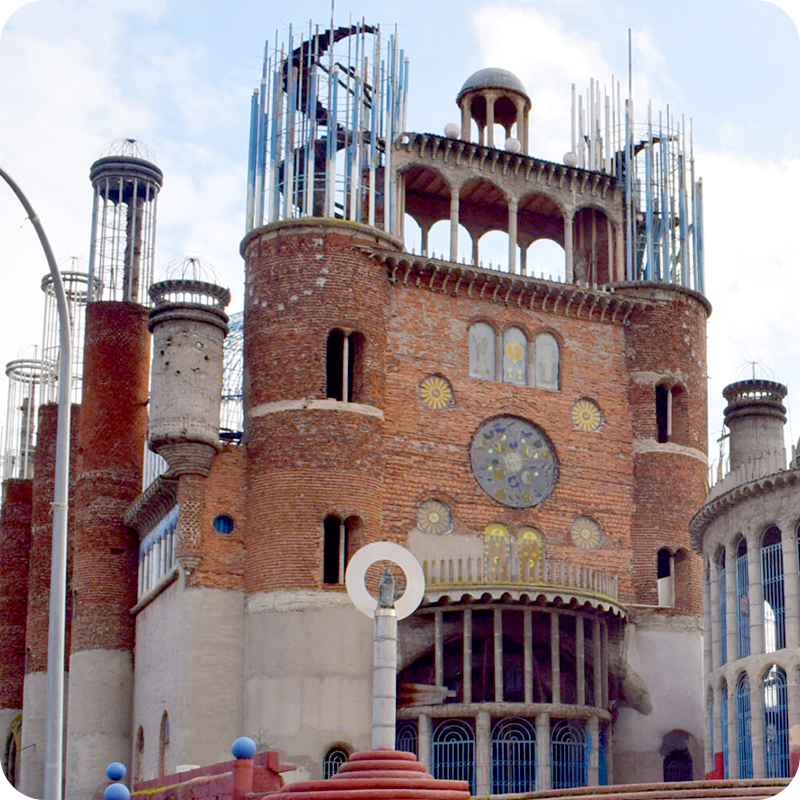
Image courtesy of Justo Catedral
Catedral de Justo-Mensajeros de la Paz, Spain
Just east of Madrid a former monk, Justo Gallego, began work on a building in 1961. By the time he died, aged 96 in 2021, Gallego had created a 4700m2 cathedral with spires standing 35m high. Gallego had no architectural or construction training and built the entire structure himself mostly using recycled and scavenged materials.
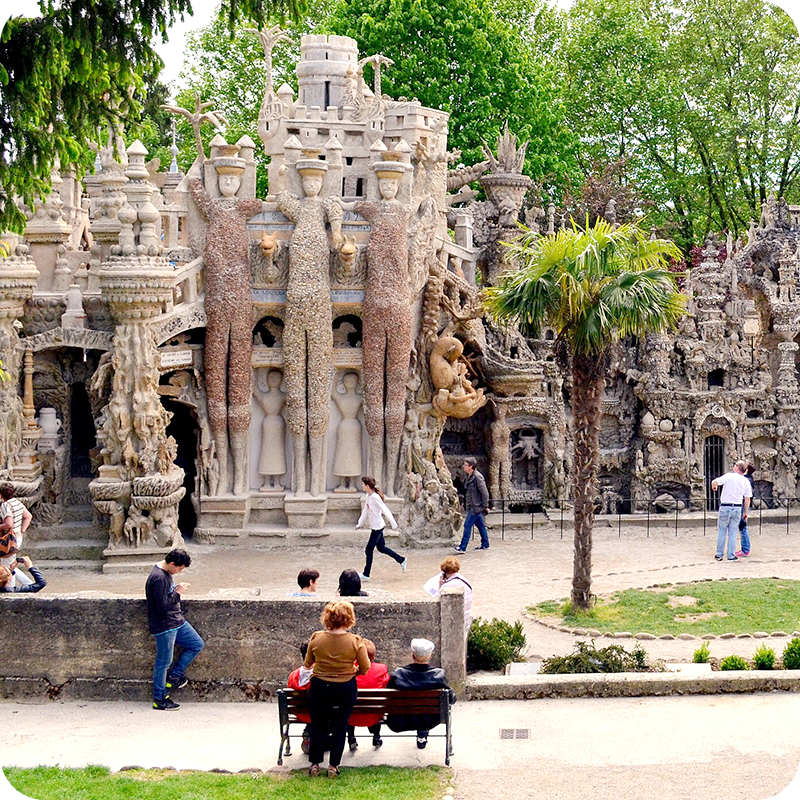
Image courtesy of Benoît Prieur
Le Palais Idéal du Facteur Cheval, France
The grandaddy of outside art/architecture – and featured in Journeys into the Outside – the Palais Idéal is the creation of Ferdinand Cheval, a rural postman. He began work on this strange, dream-like building in 1879 in his home town of Hauterives, south western France, and continued adding to it for 33 years, using rocks and stones he found on his postal round.
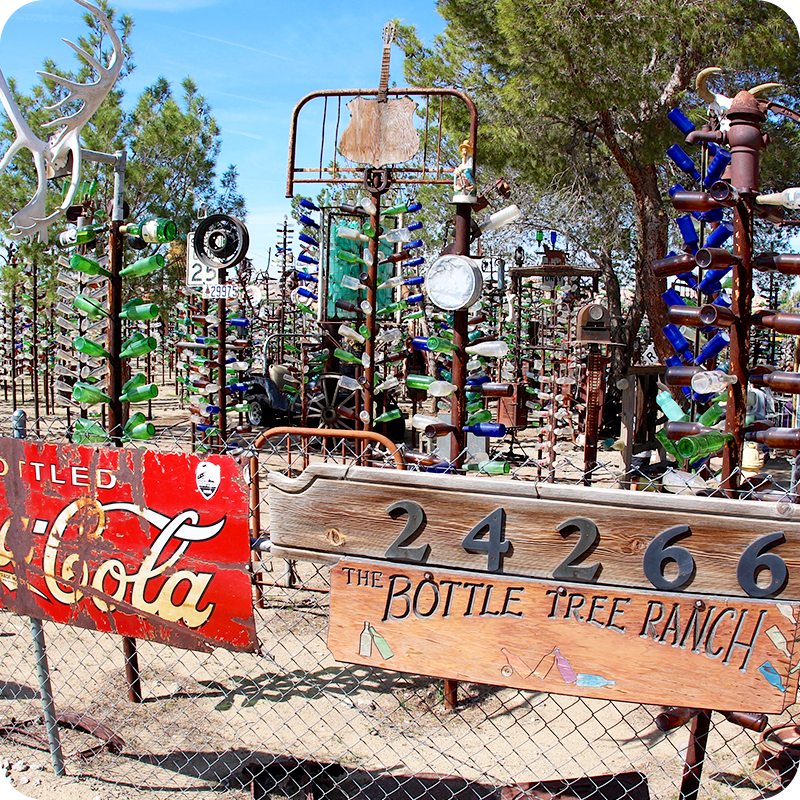
Image courtesy of David Paul Fulmer
Elmer Long’s Bottle Tree Ranch, US
Sitting on Route 66, a little north-east of LA, is the Bottle Tree Ranch. Created by Elmer Long, a former Marine, from the bottles he and his father had collected over years, it is a forest of iron poles, each with “branches” on which the bottles are suspended. It took Long about 15 years to create until his death in 2019.
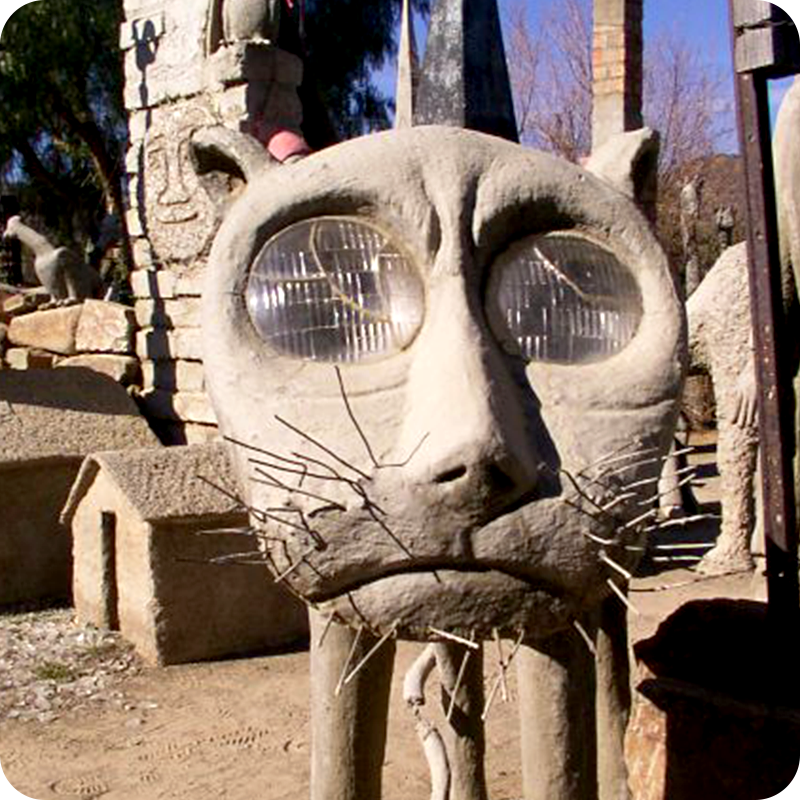
Image coutesy of Robin Tweedie
The Owl House and Camel Yard, South Africa
Beth Martins escaped the confines of very rural South Africa by transforming her childhood home into an artwork in which concrete owls were a recurring emblem. In the garden, she created dozens more sculptures, including a camel caravan heading to the far-distant coast. After her death in 1976, her legacy made this dusty, isolated village a tourist attraction.


